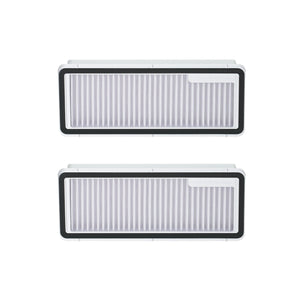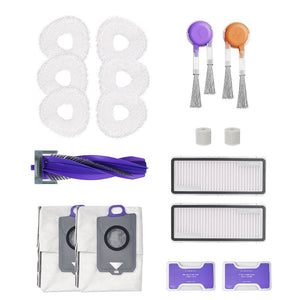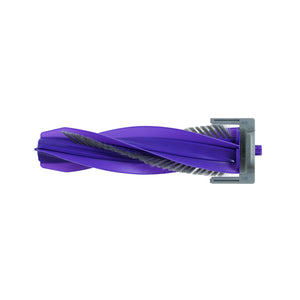Robot vacuum cleaners save time, but the question often arises: Are they energy hogs? In this article, we examine the factors that affect energy consumption, the actual cost of running a robot vacuum, and how you can further reduce these costs.
What Affects the Energy Consumption of a Robot Vacuum Cleaner?
Power Consumption and Battery Type
One key factor affecting the energy consumption of a robot vacuum is its power consumption, measured in watts (W). This indicates how much energy the device uses during operation. Typical robot vacuums consume between 20 and 100 watts, with models that offer more features and higher suction power generally requiring more energy.
Most modern robot vacuums use Lithium Ion (Li-Ion) batteries, like Narwal Freo X Ultra and Freo Z Ultra, which are considered energy efficient. Unlike nickel-metal hydride (NiMH) batteries, commonly found in older models, Li-Ion batteries have lower self-discharge and longer lifespan. A well-maintained battery can affect the runtime and frequency of charging, thereby reducing the overall energy consumption.
Usage Frequency and Operating Time
Another crucial factor is the frequency of use and the duration of cleaning cycles. Households with large spaces or multiple pets tend to use their robot vacuum more frequently. Typically, a robot vacuum takes about 1 to 2 hours to clean an average apartment of 80 to 100 square meters. Naturally, if the vacuum is used daily, the energy consumption increases accordingly.
Those who use the vacuum only once or twice a week will have significantly lower electricity costs. Therefore, it makes sense to adjust the robot’s cleaning schedule to meet actual needs.
Navigation Technology
Modern robot vacuums come with various navigation technologies that can influence energy consumption. Basic models often navigate in a chaotic mode, which means they move around the room in a random pattern. This usually results in longer cleaning times and higher energy consumption.
More advanced models use laser navigation or cameras to clean systematically. They are generally faster and more efficient as they map the room and navigate according to this map. Despite having more advanced technology, they may consume less energy overall due to their shorter operating times.
Standby Power Consumption
Even in standby mode, a robot vacuum uses energy, especially if it remains constantly connected to the charging station. Standby power consumption varies by model but is typically between 3 and 5 watts per hour. Over the course of a year, this can make up a significant portion of the total cost. Therefore, it may be a good idea to disconnect the charging station when the robot vacuum is not in use.
Motor Power
Higher motor power often leads to stronger suction, which can result in more energy consumption. Robot vacuums with powerful motors may clean more effectively but will typically use more electricity during operation, especially on carpeted surfaces.
Cleaning Modes
Robot vacuums come with different cleaning modes, such as Eco mode, Turbo mode, and Standard mode. High-power modes (like Turbo mode) consume more electricity by increasing suction power, while Eco mode uses less power by reducing suction and speed.
Floor Type and Home Layout
The type of flooring and the layout of your home also affect energy consumption. Robot vacuums consume more power when cleaning thick carpets compared to hardwood or tile floors. Additionally, homes with many obstacles can cause the vacuum to work harder, consuming more energy.
Maintenance and Upkeep
Regular maintenance, such as cleaning the brushes, filters, and sensors, ensures your robot vacuum operates efficiently. A well-maintained vacuum doesn’t have to work harder, thereby saving electricity.
Software and Firmware Updates
Software and firmware updates can improve the overall efficiency of a robot vacuum, including its power consumption. Manufacturers often release updates that optimize the vacuum’s cleaning algorithms, making it more efficient in navigating and cleaning, which can reduce energy usage. Regularly updating your robot vacuum ensures it operates at its peak efficiency, potentially lowering electricity consumption over time.
By considering these factors, you can manage your robot vacuum’s power consumption effectively, ensuring efficient cleaning while minimizing electricity usage.
How Much Do You Pay for Your Vacuum’s Electricity?
To calculate the annual cost of operating a robot vacuum, you need information on its power consumption and daily operating hours. Here’s an example calculation:
- An average robot vacuum consumes around 40 to 65 watts.
- With a daily usage of 1 hour, the daily consumption is 0.04 to 0.065 kWh.
- Multiplied over a year (365 days), this results in an annual consumption of 14.6 to 23.7 kWh.
- At an average electricity price of €0.40 per kWh, the annual cost ranges from €5.84 to €9.48.
This shows that the energy consumption of robot vacuums is relatively low compared to other household appliances. Even with daily use, the costs are manageable and amount to only a few euros per year.
How Can You Reduce the Energy Consumption of a Robot Vacuum?
Although the energy consumption of a robot vacuum is already relatively low, there are still several ways to reduce it further.
Efficient Use
Only use the robot vacuum when it’s truly necessary. In households without pets or in less frequently used areas, running the vacuum once or twice a week may be sufficient. In many cases, the home will stay clean even with less frequent cleaning.
Minimize Standby Consumption
If you’re not using the vacuum regularly, you should disconnect the charging station to minimize standby consumption. It can also help to remove the vacuum from the charging station after cleaning and reconnect it only when needed.
Prepare the Home
Before the robot vacuum starts cleaning, remove obstacles such as toys, shoes, or furniture from the floor. This allows the vacuum to work more efficiently and finish faster, reducing energy consumption.
Regular Maintenance
A well-maintained robot vacuum works more efficiently and consumes less energy. Regularly clean the brushes, filters, and wheels to ensure smooth operation. Clogged filters or dirty brushes can reduce suction power, causing the vacuum to use more energy to achieve the same result.
Adjust Cleaning Modes for Energy Efficiency
Switch to energy-saving modes such as "Eco" or "Low Power" on your robot vacuum. These modes reduce suction power and operating speed, making them ideal for regular cleaning tasks. By using less power, you save energy while still keeping your home clean.
Optimize Your Robot Vacuum's Cleaning Schedule
Take advantage of your robot vacuum’s scheduling features to plan cleaning sessions during off-peak hours or when you’re not at home. This ensures you can clean your home efficiently while also benefiting from lower electricity rates. Scheduling cleanings without having to manually start the vacuum saves both energy and time.
Use Smart Navigation Features for Efficient Cleaning
Invest in robot vacuums equipped with advanced navigation technologies like LiDAR or camera-based mapping. These smart features help your vacuum map out the most efficient cleaning paths, reducing the time spent on cleaning and thus lowering the energy consumption of your robot vacuum.
Choose an Energy-Efficient Robot Vacuum
When purchasing a robot vacuum, consider models designed for energy efficiency. Look for vacuums that offer adjustable suction power and multiple cleaning modes that adapt to different floor types. These features help optimize energy usage without compromising cleaning results.
Avoid Overcharging Your Robot Vacuum
Overcharging your robot vacuum can lead to unnecessary power consumption. To prevent this, either unplug the charging station once the vacuum is fully charged or choose a robot vacuum with built-in overcharging protection. This ensures efficient charging cycles and reduces excess energy use.
By following these steps, you can reduce the energy consumption of your robot vacuum, contributing to lower electricity costs while maintaining a clean and tidy home.
Tips for Buying an Energy-Efficient Robot Vacuum

If you’re considering buying a new robot vacuum and want to focus on energy consumption, consider the following:
-
Check the Wattage
Wattage indicates how much energy a robot vacuum requires to operate. Generally, lower wattage means less power consumption without sacrificing cleaning performance. Robot vacuums with 20 to 70 watts are often sufficient for most households and save energy.
-
Energy-Efficient Navigation Technology
Robot vacuums with modern navigation and mapping technologies like laser navigation or cameras clean faster and more efficiently. They save energy by cleaning rooms systematically rather than randomly. This reduces the time needed to clean the house, thus lowering energy consumption.
-
Battery Capacity and Charging Times
Pay attention to battery capacity and charging times. A model with a durable lithium-ion battery is usually more energy-efficient because these batteries charge faster and lose less energy. A robot that charges intelligently, for example, only when the battery is nearly empty, also contributes to energy savings.
-
Multiple Cleaning Modes
Choose a robot vacuum with various cleaning modes, such as an energy-saving mode or quiet mode. These modes consume less energy by reducing suction power, which is often sufficient for smooth floors. If your home isn’t heavily soiled, these modes can significantly reduce energy consumption.
-
Automatic Suction Adjustment
Some robot vacuums have sensors that detect the level of dirt on the floor and automatically adjust suction power. This helps save energy because the vacuum only uses full power when necessary, for instance, on carpets or heavily soiled areas.
-
Dustbin Size
A larger dustbin needs to be emptied less frequently, improving the efficiency of the cleaning process. Robot vacuums like the Narwal Freo Z Ultra, which require less frequent emptying, save time and energy as they return to the charging station less often.
-
Easy-to-Clean and Low-Maintenance Components
Choose a model with easy-to-clean brushes and filters. Keeping the vacuum clean and its parts working smoothly reduces the energy needed to operate. Dirty brushes or clogged filters can significantly increase energy consumption, as the vacuum must work harder.
-
Energy Consumption Tests and Ratings
Before purchasing, it’s wise to check energy consumption tests and ratings from independent test platforms or specialist magazines. Many of these tests provide detailed insights into the energy usage and efficiency of a robot vacuum, making it easier to find a model that suits your needs.
Top Energy-Efficient Robot Vacuums for Your Home
When considering an energy-efficient robot vacuum, you’ll want to prioritize models that balance strong performance with low energy consumption. Here are three top choices that offer both power and efficiency:
Narwal Freo Z Ultra
The Narwal Freo Z Ultra stands out for its advanced AI technology and dual RGB cameras, which help optimize cleaning and reduce energy usage by navigating your home efficiently. With 12,000Pa suction power, it offers powerful cleaning while using just 65W of power. Thanks to its auto-cleaning and self-emptying base, it minimizes the need for frequent charging, making it an energy-saving option for busy households.
Key Features:
-
AI-powered navigation for optimized energy use
-
12000Pa suction ensures strong performance with minimal power usage
-
Self-cleaning base reduces maintenance and energy consumption over time
[cta:narwal-freo-z-ultra-robot-vacuum-mop]
Narwal Freo X Ultra
The Narwal Freo X Ultra combines a robust 8,200Pa suction power with smart navigation, which reduces unnecessary energy consumption. Its 65W power ensures effective cleaning while keeping electricity usage low. The innovative Zero Tangling Brush and AI DirtSense technology allow it to clean efficiently without excessive power drains, making it perfect for homes with pets and high foot traffic.
Key Features:
-
8200Pa suction with energy-efficient design
-
Zero Tangling Brush reduces maintenance and increases efficiency
-
AI DirtSense ensures targeted cleaning to avoid overworking the vacuum
[cta:narwal-freo-x-ultra-robot-vacuum-mop]
Narwal Freo X Plus
The Narwal Freo X Plus offers 7,800Pa suction and is designed with energy-saving features like 3D mapping and LiDAR navigation, which help minimize cleaning time and electricity usage. It automatically adjusts cleaning power depending on the type of floor, making it ideal for a variety of surfaces. Plus, its 7-week dust storage reduces the need for frequent emptying, further contributing to its energy efficiency.
Key Features:
-
7800Pa suction for deep cleaning with lower energy usage
-
LiDAR navigation ensures smart and efficient cleaning paths
-
7-week dust storage reduces the need for frequent recharging
[cta:narwal-freo-x-plus-robot-vacuum-and-mop]
These three models, while offering excellent cleaning capabilities, are designed with energy conservation in mind. Whether you have pets, carpets, or hard floors, each of these models efficiently manages power without sacrificing performance.
Robot Vacuums vs. Traditional Vacuums: Which Uses More Power?
Compared to traditional vacuums, robot vacuums are much more energy-efficient. A classic upright vacuum cleaner requires between 800 and 1,600 watts. Even with only 1 to 2 hours of use per week, annual power consumption can reach around 60 to 80 kWh, which results in electricity costs of approximately €24 to €32.
In contrast, the power consumption of a robot vacuum used daily is only 15 to 25 kWh per year, resulting in annual costs of about €6 to €10. Therefore, robot vacuums are often more energy-efficient in the long run, especially when used as a complement to traditional vacuums.
Conclusion
Robot vacuums are not energy hogs. On the contrary, their energy consumption is low compared to traditional vacuum cleaners. Even with daily use, electricity costs remain manageable, and with some simple measures, the consumption can be further reduced. By choosing energy-efficient models and using them strategically, you can save both time and effort, as well as keep electricity costs low.

FAQs
Should You Turn Off a Robot Vacuum?
It’s not necessary to completely turn off a robot vacuum. However, it can be a good idea to disconnect the charging station from the power grid to minimize standby consumption.
Should I Leave My Robot Vacuum Plugged In?
It’s okay to leave the vacuum at the charging station, as most models stop drawing power once fully charged. However, to save energy, you can unplug it when not in use.
Can Robot Vacuums Catch Fire?
The likelihood of a robot vacuum catching fire is extremely low, as long as it’s used properly and there are no technical defects. However, it’s important not to leave the vacuum unattended while charging and to regularly check the charger and battery for signs of damage.





















































